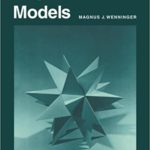You may be asking ‘has Colin invented all these shapes, or did he get them out of a book?’ The truth is a mixture of the two: there are some wonderful classic books on Polyhedra (though even now there are only four that I consider worth owning); but actually I did work out some of this stuff in my own head and on my own desk before I became aware of the books. So I claim that I’ve done at least some of the thinking here myself!
The four books in question are:
Cundy & Rollett: Mathematical Models (First discovered in the 6th form library at Newcastle Royal Grammar School, and loved ever since.)
Wenninger: Polyhedron Models (A marvellous updating and expansion of the topic in the 1970s.)
Wenninger: Dual Models (his Spherical Models has never particularly inspired me, but Dual Models is a triumphant follow-on from Polyhedron Models.)
Coxeter, The 59 Icosahedra (The daddy of them all, and still the classic text on the Stellations of the Icosahedron.)
Wenninger’s books are published by Cambridge University Press: the others are nowadays available as reprints from the excellent Tarquin Publications of Norwich.
These four books are the bibles of this subject: a must-have if you want to build the more complex models, and an absolutely solid reference point for discussion. They’re never far from my bedside, and in fact there’s rarely a day when I don’t look into one or more of them.
Beyond this I’d commend Coxeter’s Regular Polytopes if you want to get into higher-dimensional space, but actually it’s very hard-going for little visual reward and I don’t usually get very far with it.
There are virtually no other books worth reading on good standard 3-dimensional polyhedron models. In a way this lack of publication seems sad, but perhaps once it’s been said it doesn’t need saying again; and to write a credible book on these topics you really ought to have built the models. I suspect very few are doing that these days: the one or two books that do appear are basically just coffee-table fodder full of computer-generated images and meaningless writing around them.
From time to time booklets also appear with “nets” to cut out so that you can make the models without going too deeply into the fundamental geometry. I haven’t bothered discussing nets here, but these booklets are a great resource. They’re excellent for the general reader and certainly for children, and I’ve even made some of them myself – particularly the 6th, 9th and final Stellations of the Icosahedron, and there are lots to put into a huge collection of Oddities some day. Tarquin have made a particular point of keeping these booklets in print, and they’re well worth a look.
It is, of course, all available on the web – Wolfram Mathworld – Polyhedra is a wonderful resource. So is Wikipedia, and there are a few other model builders (George Hart, Robert Webb…) who’ve put up photos of their own work (I’ll write about them later.) There are also a couple of Facebook groups and other discussion fora, and there’s software coming available like Stella.
But none of this comes close to the thrill of assembling one of these models from scratch with cardboard and glue, and then holding it in your own hands. It’s a sad fact that most professional mathematicians have never made any of these shapes: even if they make some of the Platonic solids in primary school, most never come near making even a Dodecahedron with an adult mathematician’s understanding of what they’re doing.
So where now? There’s lots of detailed stuff at More or Details, where I discuss some of the Polyhedra in absolute detail – but this part is not properly written up yet so it’s a bit patchy. If you fancy a change, you could try Origami.



